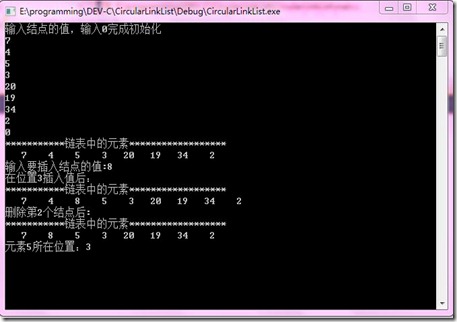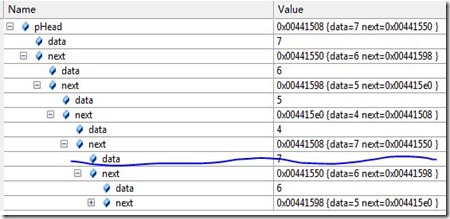数据结构之表(4)单循环链表
链表、双链表、单循环链表、双循环链表 的实现代码都差不多,区别只是在对指针域的修改。下面,是对单循环链表的实现
1: # include <stdio.h>
2: # include <stdlib.h>
3:
4: /*存储结构的定义*/
5: typedef struct node_tag {
6: int data ;
7: struct node_tag * next ;
8: }node;
9:
10: /************************************************************************/
11: /* 操作 */
12: /************************************************************************/
13:
14: /*初始化循环链表*/
15: void ds_init(node ** pNode) {
16: int item ;
17: node * temp ;
18: node * target ;
19:
20: printf("输入结点的值,输入0完成初始化\n");
21: while(1) {
22: scanf("%d",&item) ;
23: fflush(stdin) ;
24: if(item == 0)
25: return ;
26:
27: if((*pNode) == NULL) { /*循环链表中只有一个结点*/
28: *pNode = (node*)malloc(sizeof(struct node_tag)) ;
29: if(!(*pNode))
30: exit(0) ;
31: (*pNode)->data = item ;
32: (*pNode)->next = *pNode ;
33: }
34: else {
35: /*找到next指向第一个结点的结点*/
36: for(target = (*pNode) ; target->next != (*pNode) ; target = target->next) ;
37:
38: /*生成一个新的结点*/
39: temp = (node *) malloc(sizeof(struct node_tag)) ;
40: if(!temp)
41: exit(0) ;
42: temp->data = item ;
43: temp->next = *pNode ;
44: target->next = temp ;
45: }
46: }
47: }
48:
49: /*插入结点*/
50: /*参数:链表的第一个结点,插入的位置*/
51: void ds_insert(node ** pNode ,int i) {
52: node * temp ;
53: node * target ;
54: node * p ;
55: int item ;
56: int j = 1 ;
57:
58: printf("输入要插入结点的值:");
59: scanf("%d",&item) ;
60:
61: if(i == 1) { //新插入的结点作为第一个结点
62: temp = (node *)malloc(sizeof(struct node_tag)) ;
63: if(!temp)
64: exit(0) ;
65: temp ->data = item ;
66:
67: /*寻找到最后一个结点*/
68: for(target = (*pNode) ; target->next != (*pNode) ; target = target->next) ;
69: temp->next = (*pNode) ;
70: target->next = temp ;
71: *pNode = temp ;
72: }
73: else {
74: target = *pNode ;
75: for( ; j < (i-1) ; target=target->next,++ j) ;
76: temp = (node *)malloc(sizeof(struct node_tag)) ;
77: if(!temp)
78: exit(0) ;
79: temp ->data = item ;
80: p = target->next ;
81: target->next = temp ;
82: temp->next = p ;
83: }
84: }
85:
86: /*删除结点*/
87: void ds_delete(node ** pNode,int i) {
88: node * target ;
89: node * temp ;
90: int j = 1 ;
91:
92: if(i == 1) { //删除的是第一个结点
93: /*找到最后一个结点*/
94: for(target = *pNode ; target->next != *pNode ;target = target->next) ;
95: temp = *pNode ;
96: *pNode = (*pNode)->next ;
97: target->next = *pNode ;
98: free(temp) ;
99: }
100: else {
101: target = *pNode ;
102: for( ; j < i-1 ; target= target->next,++j) ;
103: temp = target->next ;
104: target->next = temp->next ;
105: free(temp) ;
106: }
107: }
108:
109: /*返回结点所在位置*/
110: int ds_search(node * pNode,int elem) {
111: node * target ;
112: int i = 1 ;
113:
114: for(target = pNode ; target->data != elem && target->next != pNode ; ++i , target = target->next) ;
115: if(target->next == pNode) /*表中不存在该元素*/
116: return 0 ;
117: else
118: return i ;
119: }
120: /*遍历*/
121: void ds_traverse(node * pNode) {
122: node * temp ;
123: temp = pNode ;
124: printf("***********链表中的元素******************\n");
125: do {
126: printf("%4d ",temp->data) ;
127: }while((temp = temp->next) != pNode) ;
128: printf("\n") ;
129: }
测试程序
1: int main()
2: {
3: node * pHead = NULL ;
4: ds_init(&pHead) ;
5: ds_traverse(pHead) ;
6: ds_insert(&pHead,3) ;
7: printf("在位置3插入值后:\n") ;
8: ds_traverse(pHead) ;
9:
10: ds_delete(&pHead,2) ;
11: printf("删除第2个结点后:\n") ;
12: ds_traverse(pHead) ;
13: printf("元素5所在位置:%d\n",ds_search(pHead,5)) ;
14: fflush(stdin) ;
15: getchar() ;
16: return 0 ;
17: }
运行结果:
要想看循环链表的存储结构,可以在初始化完成后,加入断点查看,结果下图:







